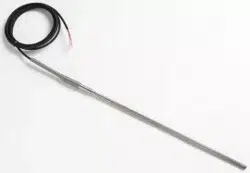Loading ...
Loading ...
Loading ...

7 Troubleshooting
7.1 Troubleshooting
In the event that the probe appears to function abnormally, this section may be
of use in solving the problem. Several possible problem conditions are de
-
scribed along with likely causes and solutions. If a problem arises, please read
this section carefully and attempt to understand and solve the problem. If the
probe seems faulty or the problem cannot otherwise be solved, contact an Au
-
thorized Service Center (see Section 1.3) for assistance. Be sure to have the
model number and serial number of your probe available.
Problem
Causes and Solutions
Data changes greater than 0.1°C
are observed
Mechanical shock can cause temperature errors as great as 0.5°C. If
this is observed, first measure and record the Rtpw.
Data changes less than 0.1°C
Slight mechanical shock can cause temperature errors less than
0.1°C.
Data unstable
If the data is unstable at the Triple Point of Water (TPW), check con-
nections for evidence of a bad connection. If the connector appears
to be in good condition and the connections are good, the PRT may
be damaged. Contact an Authorized Service Center (see Section
1.3).
• If the data is unstable at high temperatures, it may be
due to electrical noise in the system. Reduce the tem-
perature and observe the data. If it is stable, electrical
noise is interfering with the measurements at high tem-
peratures. Also, this is usually due to low shunt resis-
tance. The resistance between the leads and the sheath
(shunt resistance or insulation resistance) as measured
by a resistance meter should be greater than 500 meg
-
ohms at room temperature. Check the grounding of the
readout device and the heat source. A faulty ground on
either device could interfere with high temperature mea
-
surements. A ground wire attached to the metal sheath
of the PRT may help to reduce electrical noise interfer
-
ence.
Temperature readout different
than expected, e.g. the heat
source is set at 150°C, the PRT
measures 125°C.
Measure the PRT resistance at TPW.
•
If the resistance of the PRT is less than the rated resis
-
tance, e.g. 98 ohms for a 100 ohm PRT, there may be a
short in the sensor.
•
If the resistance of the PRT is only a few ohms, there
may be a short in the four lead-wires.
•
If the PRT is open, the resistance will be “Out of Limits”
or in the kilohm or megohm range.
For more information or assistance, contact an Authorized Service
Center (see Section 1.3).
15
7 Troubleshooting
Troubleshooting
1.888.610.7664 sales@GlobalTestSupply.com
Fluke-Direct.com
